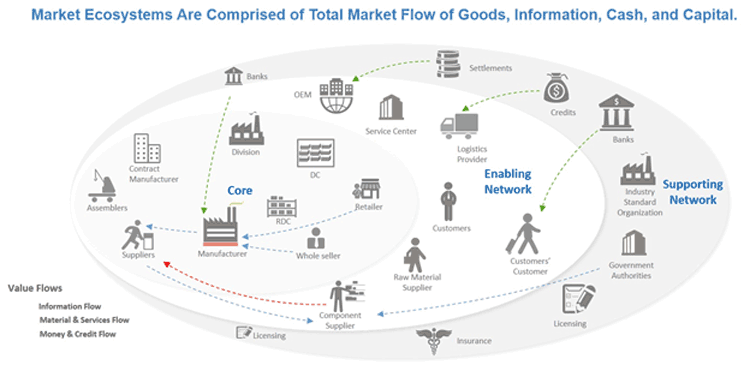Just usually one week per year. SCDigest editor Dan Gilmore turns over the powerful First Thoughts podium to an guest contributor. This time, it is friend of SCDigest Rich Sherman, senior fellow at the Supply Chain Center of Excellence at Tata Consultancy and long time supply chain analyst, who has taken this turn for SCDigest one or twice before. Below starts his column, on changes needed to support Omnichannel commerce..
As more companies move to online, they are embracing Omnichannel Fulfillment strategies. Piece pick, parcel ship, and home delivery combined with pick in store with multiple order pickup and delivery options increases the volume of small orders and requires new space requirements in existing distribution facilities.
Sherman Says.... |
 |
| If you're not starting to feel the cost disruption resulting from more frequent, smaller orders and shipments as Ommichannel Fulfillment strategies take hold, you will. |
 |
What do you say? |
|
| Click here to send us your comments |
| |
|
|
|
As a result, to free up space to implement the new strategies,retailers are pushing back on supplier VMI initiatives and returning to more frequent ordering in smaller quantities that puts pressure on load building and increased transportation cost due to the inability to consolidate orders into efficient full truckload, plant direct shipments.
Supply Chain Visibility Is Required; But, Is It Enough?
Companies are realizing that their supply chain is not really a chain at all. It is a supply network and with Omnichannel Fulfillment it is becoming even more complex. To address this complexity, companies are implementing "control towers" to enable their enterprise supply network (ESN) with connectivity to trading partners for visibility and to optimize the flow of goods (inbound and outbound loads) within their ESN.
However, as control towers are implemented, visibility to the flow of goods reveals that the ESN is simply a node in an Ecosystem Supply Network of Networks community of commerce. Market ecosystems are comprised of all of the participants in the market ecosystem (see graphic below), including not only trading partners, but suppliers', customers', competitors', and their suppliers', customers', and competitors' ESNs as well. (And, not to mention, including all of the support enterprise networks as well).
Example of a Market Ecosystem

Just as each airport has a control tower to manage and control inbound and outbound flight traffic, enterprise supply networks have a control tower to manage and control inbound and outbound loads of enterprise goods traffic. The emerging issue is that while these control towers provide visibility and control over their loads, they don't have visibility to all of the loads in the market ecosystem in which they operate.
ESN complexity results not just from the enterprise flow of goods, but also to the competing "invisible" flow of goods from competitors', suppliers', and customers' ESNs that must also adapt to changing demand, resource constraints, bottlenecks to flow, capacity utilization/availability, and the plethora of variability, tradeoffs, and uncertainty that has plagued operations for years. Therefore, we have to ask: is supply chain visibility enough?
New Applications That Leverage New and Existing Sources of Data and Digitalization to Optimize Ecosystem Resources and Flow of Goods Are Required
Individual airport control towers take their orders from the Air Traffic Control (ATC) system that is not a control tower; rather it is a network of control tower networks with visibility to all of the flight traffic in its airspace (ecosystem). Multi-Enterprise Supply Chain Business Platforms, as Gartner calls them, have been connecting communities of commerce within market ecosystems for years. Most of them have emerged from EDI transaction management, marketplaces, and collaborative industry initiatives. They are leveraging Business 4.0 digital technologies such as cloud computing, mobility, the IoT, AI/BI, etc. to optimize business processes across the market ecosystem.
The multi-enterprise supply chain business platform providers are "quietly" building, what I am calling ERP 4.0 or Ecosystem Resource Planning, a new wave of operations technology in the Business 4.0 digital environment. The first operations breakthrough "wave" was Material Requirements Planning (MRP), followed by the second wave, Manufacturing Resource Planning (MRPII) and the third wave, coined by former Gartner analyst Erik Keller, Enterprise Resource Planning (ERP). Whether you call our current fourth wave the "Connected Age" as I did in my book, or Industry 4.0, or Business 4.0, the underlying enabling technology that will lead ESN maturity will be an ecosystem planning and optimization application suite, ERP 4.0.
Look to the "Next Big Thing" in ERP 4.0 Suites to Optimize and Synchronize Ecosystem Flow of Goods
 The leading multi-enterprise platform providers, E2open, One Network Enterprises, Infor Nexus, SupplyOn, and others are developing and/or acquiring operations applications that are evolving to the emergence of ERP4.0 suites. ERP 4.0 suites that will enable ESNs to connect to an ecosystem platform that enables the optimization and synchronization of ecosystem flows of goods to lower the cost and complexity of integrating enterprise flows of goods within an ecosystem's multi-enterprise traffic flow of goods. The leading multi-enterprise platform providers, E2open, One Network Enterprises, Infor Nexus, SupplyOn, and others are developing and/or acquiring operations applications that are evolving to the emergence of ERP4.0 suites. ERP 4.0 suites that will enable ESNs to connect to an ecosystem platform that enables the optimization and synchronization of ecosystem flows of goods to lower the cost and complexity of integrating enterprise flows of goods within an ecosystem's multi-enterprise traffic flow of goods.
ERP 4.0 requires a certain amount of neutrality in the collection, consolidation, and federation of data, information, and commerce transactions. It implies deployment by what Gartner calls multi-enterprise supply chain business platforms (MESCBP) or, sorry Gartner, as I like to call them, Ecosystem Commerce Platforms (ECP). ECPs are dependent upon scaled subscriptions by common interest connected communities of commerce. Business 4.0, in general, is dependent on connectivity, I don't see any one standardized cross industry ECP, rather I think we will see ECPs deployed based on current industry community adoption and will compete and consolidate over time similar to the evolution and consolidation of the current ERP market.
If you're not starting to feel the cost disruption resulting from more frequent, smaller orders and shipments as Ommichannel Fulfillment strategies take hold, you will. It's time to start looking beyond visibility and into the promise that ERP 4.0 and ECPs offer.
What is your reaction to Sherman's column on the impact of new ecommerce ecosystems? Let us know your thoughts at the Feedback button or section below.
Your Comments/Feedback
|
|
Jan H Jansen
Senior lecturer / Researcher Supply Chain Finance & Blockchain, Hogeschool Arnhem Nijmegen (HAN) |
Posted on: Apr, 05 2020 |
|
Interesting article!
Curious how it fits into supply chain finance and enterprise blockchain.
|
|
|